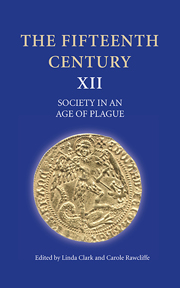Book contents
- Frontmatter
- Contents
- List of Illustrations
- Contributors
- Preface
- Abbreviations
- Introduction
- Looking for Yersinia Pestis: Scientists, Historians and the Black Death
- Pestilence and Poetry: John Lydgate's Danse Macabre
- Pilgrimage in ‘an Age of Plague’: Seeking Canterbury's ‘hooly blisful martir’ in 1420 and 1470
- An Urban Environment: Norwich in the Fifteenth Century
- Mid-Level Officials in Fifteenth-Century Norwich
- Leprosy and Public Health in Late Medieval Rouen
- Plague Ordinances and the Management of Infectious Diseases in Northern French Towns, c.1450–c.1560
- The Renaissance Invention of Quarantine
- Coping with Epidemics in Renaissance Italy: Plague and the Great Pox
- The Historian and the Laboratory: The Black Death Disease
- Index
- CONTENTS OF PREVIOUS VOLUMES
Coping with Epidemics in Renaissance Italy: Plague and the Great Pox
Published online by Cambridge University Press: 05 September 2013
- Frontmatter
- Contents
- List of Illustrations
- Contributors
- Preface
- Abbreviations
- Introduction
- Looking for Yersinia Pestis: Scientists, Historians and the Black Death
- Pestilence and Poetry: John Lydgate's Danse Macabre
- Pilgrimage in ‘an Age of Plague’: Seeking Canterbury's ‘hooly blisful martir’ in 1420 and 1470
- An Urban Environment: Norwich in the Fifteenth Century
- Mid-Level Officials in Fifteenth-Century Norwich
- Leprosy and Public Health in Late Medieval Rouen
- Plague Ordinances and the Management of Infectious Diseases in Northern French Towns, c.1450–c.1560
- The Renaissance Invention of Quarantine
- Coping with Epidemics in Renaissance Italy: Plague and the Great Pox
- The Historian and the Laboratory: The Black Death Disease
- Index
- CONTENTS OF PREVIOUS VOLUMES
Summary
This article will examine and compare the way that society coped with two of the major epidemics to affect Renaissance Italy: plague and the Great Pox. Even though these diseases impacted on Italy as severely as they did on the rest of Europe, different countries devised different solutions to the same problems. Discussing the strategies that Italy adopted in the long fifteenth century is valuable not just to those who work on Italian Renaissance history, but also to historians of countries such as England which developed very different measures. Indeed, in the sixteenth century, in the case of plague, the privy council and statesmen such as William Cecil, Lord Burghley, looked to continental and particularly Italian plague measures as a reflection of their ‘civility’, which made them worthy of imitation.
The main elements which constituted this ‘civility’ will be the subject of the first part of this article, which will examine society's reactions to plague in Renaissance Italy through the prism of how contemporaries understood the nature of the disease. One of the more traditional themes of historical studies of Italian plague is the idea that at the time there was a marked division in beliefs between doctors and health boards about how disease was spread, with the former supporting the idea of infected air, or miasma, and the latter espousing contagionist views. This story is complicated still further from the late fifteenth century by the emergence of the Great Pox.
- Type
- Chapter
- Information
- The Fifteenth Century XIISociety in an Age of Plague, pp. 175 - 194Publisher: Boydell & BrewerPrint publication year: 2013



